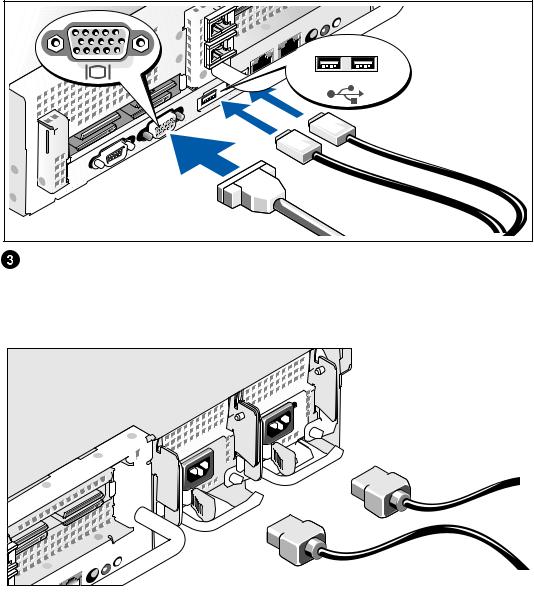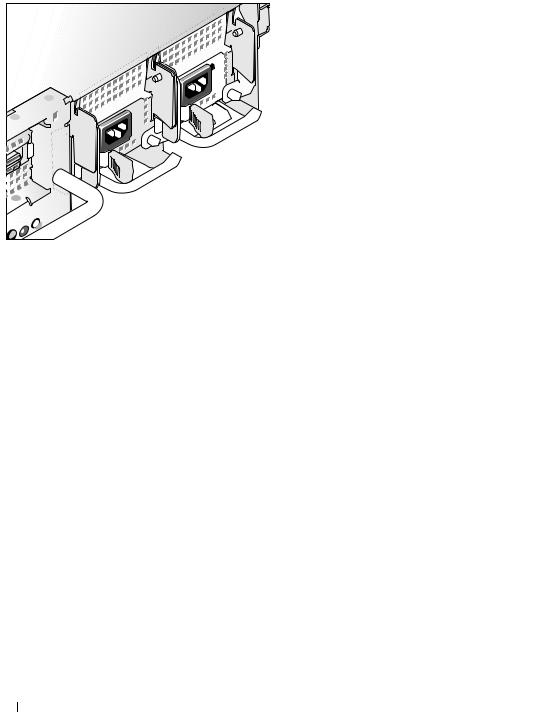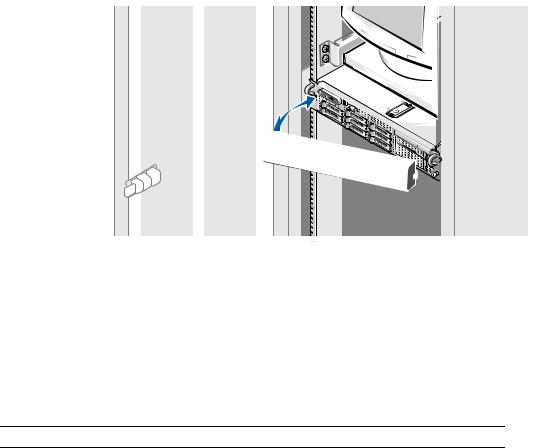Dell 2970, MN535 User Manual
Dell™ PowerEdge™ 2970 Systems
Getting Started With
Your System
Guide de mise en route
Primeiros passos com o sistema
Procedimientos iniciales con el sistema
Model EMS01
w w w . d e l l . c o m | s u p p o r t . d e l l . c o m
Dell™ PowerEdge™ 2970 Systems
Getting Started With
Your System
w w w . d e l l . c o m | s u p p o r t . d e l l . c o m

Notes, Notices, and Cautions
NOTE: A NOTE indicates important information that helps you make better use of your computer.
NOTICE: A NOTICE indicates either potential damage to hardware or loss of data and tells you how to avoid the problem.
 CAUTION: A CAUTION indicates a potential for property damage, personal injury, or death.
CAUTION: A CAUTION indicates a potential for property damage, personal injury, or death.
____________________
Information in this document is subject to change without notice. © 2007 Dell Inc. All rights reserved.
Reproduction in any manner whatsoever without the written permission of Dell Inc. is strictly forbidden.
Trademarks used in this text: Dell and the DELL logo are trademarks of Dell Inc.; AMD and AMD Opteron are registered trademarks of Advanced Micro Devices; Microsoft, Windows, and Windows Server are registered trademarks of Microsoft Corporation; Novell and NetWare are registered trademarks of Novell, Inc.; Red Hat and Red Hat Enterprise Linux are registered trademarks of Red Hat, Inc.; SUSE is a registered trademark of Novell Inc.
Other trademarks and trade names may be used in this document to refer to either the entities claiming the marks and names or their products. Dell Inc. disclaims any proprietary interest in trademarks and trade names other than its own.
Model EMS01
January 2007 |
P/N MN535 |
Rev. A00 |

System Features
This section describes the major hardware and software features of your system. It also provides information about other documents you may need when setting up your system and how to obtain technical assistance.
•One or two dual-core AMD Opteron™ processors. One or two quad-core AMD Opteron™ processors (when available).
•A minimum of 1 GB (single-processor systems) or 2 GB (two-processor systems) of 667-MHz registered parity DDR-II memory modules. Memory is upgradable to a maximum of 32 GB (two-processor systems) by installing combinations of 512-MB, 1-GB, 2-GB, or 4-GB memory modules in the eight memory module sockets on the system board. (64 GB of memory will be supported when 8 GB memory modules are available.)
•Support for up to eight 2.5-inch, internal hot-pluggable Serial Attached SCSI (SAS) or SATA hard drives.
•The optional media bay provides support for an optional half-height tape backup unit (TBU) and an optional slim-line 1.44-MB diskette drive.
•An optional slim-line IDE CD, DVD, or combination CD-RW/DVD drive.
NOTE: DVD devices are data only.
•An intrusion switch that signals the appropriate systems management software if the cover is opened.
•Up to two hot-pluggable, 750-W power supplies in an optional 1 + 1 redundant configuration.
•Four hot-pluggable system cooling fans.
The system board includes the following features:
•A left riser card that has one full-length PCIe x8 lane slot and one half-length PCIe x4 lane slot.
•A center riser card that has one half-length PCIe x8 lane slot.
•A dedicated slot for an integrated SAS host bus adapter, which supports up to four 2.5-inch SAS or SATA hard drives, or an optional RAID controller card with 256 MB of cache memory and
a RAID battery, which supports up to eight 2.5-inch SAS or SATA hard drives.
NOTE: System boot is not supported from an external device attached to a SAS or SCSI adapter, including SAS 5/E, PERC 5/E, or PERC 4e/DC. See support.dell.com for the latest support information about booting from external devices.
•Two integrated Gigabit Ethernet NICs, capable of supporting 10-Mbps, 100-Mbps, and 1000-Mbps data rates.
Getting Started With Your System |
3 |

•Four external USB 2.0-compliant connectors (two on the front and two on the back) supporting a diskette drive, a DVD-ROM drive, a keyboard, a mouse, or a USB flash drive.
•One internal USB 2.0-compliant connector supporting an optional bootable USB flash drive for customized boot configurations.
•Optional remote access controller (RAC) for remote systems management.
•An integrated VGA-compatible video subsystem based on an integrated ATI ES1000 33-MHz PCI video controller. The video subsystem includes 32MB of graphics memory and supports various
2D graphics video modes. Maximum resolution is 1600x1200 with 65,536 colors. (When the optional RAC is installed, the maximum resolution of the integrated video subsystem is 1280x1024.)
•Systems management circuitry that monitors operation of the system fans as well as critical system voltages and temperatures. The systems management circuitry works in conjunction with the systems management software.
•Standard Baseboard Management Controller (BMC) with serial and LAN access.
•Back-panel connectors include one serial, one video, two USB, and two NIC connectors.
•Front-panel connectors include a video and two USB connectors.
•Front-panel 1x5 LCD for system ID and error messaging.
•System ID button on the front and back panels.
For more information about specific features, see Technical Specifications.
Supported Operating Systems
•Microsoft® Windows Server® 2003 R2 Standard and Enterprise Editions (SP1 and later)
•Microsoft Windows Server 2003 R2 Standard and Enterprise x64 Editions (SP1 and later)
•Red Hat® Enterprise Linux® AS and ES (Version 4) (x86)
•Red Hat® Enterprise Linux® AS and ES (Version 4) (x86_64)
•Red Hat Enterprise Linux Server 5 (x86)
•Red Hat Enterprise Linux Server 5 (x86_64)
•SUSE® Linux Enterprise Server 10 (x86_64)
NOTE: For the latest information on supported operating systems, see www.dell.com.
4 Getting Started With Your System

Other Information You May Need
CAUTION: The Product Information Guide provides important safety and regulatory information. Warranty information may be included within this document or as a separate document.
•The Rack Installation Guide or Rack Installation Instructions included with your rack solution describes how to install your system into a rack.
•The Hardware Owner’s Manual provides information about system features and describes how to troubleshoot the system and install or replace system components.
•CDs included with your system provide documentation and tools for configuring and managing your system.
•Systems management software documentation describes the features, requirements, installation, and basic operation of the software.
•Operating system documentation describes how to install (if necessary), configure, and use the operating system software.
•Documentation for any components you purchased separately provides information to configure and install these options.
•Updates are sometimes included with the system to describe changes to the system, software, and/or documentation.
NOTE: Always check for updates on support.dell.com and read the updates first because they often supersede information in other documents.
•Release notes or readme files may be included to provide last-minute updates to the system or documentation or advanced technical reference material intended for experienced users or technicians.
Obtaining Technical Assistance
If you do not understand a procedure in this guide or if the system does not perform as expected, see your Hardware Owner’s Manual.
Dell™ Enterprise Training and Certification is available; see www.dell.com/training for more information. This service may not be offered in all locations.
Installation and Configuration
CAUTION: Before performing the following procedure, read and follow the safety instructions and important regulatory information in your Product Information Guide.
This section describes the steps to set up your system for the first time.
Getting Started With Your System |
|
5 |
|

Unpacking the System
Unpack your system and identify each item.
Keep all shipping materials in case you need them later.
Installing the Rails and System in a Rack
Once you have read the "Safety Instructions" located in the rack installation documentation for your system, install the rails and the system in the rack.
See your rack installation documentation for instructions on installing your system in a rack.
6 Getting Started With Your System

Connecting the Keyboard, Mouse, and Monitor
Connect the keyboard, mouse, and monitor (optional).
The connectors on the back of your system have icons indicating which cable to plug into each connector. Be sure to tighten the screws (if any) on the monitor's cable connector.
Connecting the Power
Connect the monitor’s power cable to the monitor (optional), and connect the system’s power cable(s) to the system.
Getting Started With Your System |
|
7 |
|

Installing the Power Cord Retention Bracket
Attach the power cord retention bracket on the right bend of the power supply handle. Bend the system power cable into a loop as shown in the illustration and attach to the bracket’s cable clasp. Repeat the procedure for the second power supply.
Plug the other end of the power cables into a grounded electrical outlet or a separate power source such as an uninterrupted power supply (UPS) or a power distribution unit (PDU).
Turning on the System
Turn on the system and monitor (optional).
With the bezel removed, press the power button on the system and the monitor. The power indicators should light. Adjust the monitor's controls until the displayed image is satisfactory.
8 Getting Started With Your System

Installing the Bezel
Install the bezel (optional).
Complete the 0perating System Setup
If you purchased a preinstalled operating system, see the operating system documentation that ships with your system. To install an operating system for the first time, see the Quick Installation Guide. Be sure the operating system is installed before installing hardware or software not purchased with the system.
Technical Specifications
Processor
Processor type |
One or two dual-core AMD Opteron processors |
|
One or two quad-core AMD Opteron processors |
|
(when available) |
|
|
Expansion Bus |
|
|
|
Bus type |
PCIe |
Expansion slots |
|
Center riser: |
|
PCIe |
One x8 full-height, half-length 3.3-V slot |
Left riser |
|
PCIe option: |
One x8 full-height, full-length 3.3-V slot |
|
One x4 full-height, half-length 3.3-V slot |
Getting Started With Your System |
|
9 |
|

Memory
Architecture |
667-MHz registered parity DDR-II memory |
|
modules |
Memory module sockets |
Eight 240-pin |
Memory module capacities |
512 MB, 1 GB, 2 GB, or 4 GB |
|
(8 GB when available) |
Minimum RAM |
1 GB (one processor) or 2 GB (two processors) |
Maximum RAM |
16 GB (one processor) or 32 GB (two processors) |
|
(32 GB (one processor) or 64 GB (two processors) |
|
when 8 GB memory modules are available) |
|
|
Drives |
|
|
|
Hard drives |
Up to eight 2.5-inch, hot-plug SAS or SATA |
|
internal drives |
Diskette drive |
One optional slimline 1.44-MB |
|
External optional USB 1.44-MB |
Optical drive |
One optional slimline IDE CD, DVD, |
|
or combination CD-RW/DVD |
|
NOTE: DVD devices are data only. |
|
External optional USB DVD |
Tape drive |
One optional internal half-height tape backup |
|
device |
Flash drive |
External optional USB |
|
Internal optional USB |
|
|
Connectors |
|
|
|
Back |
|
NIC |
Two RJ-45 (for integrated 1-GB NICs) |
Serial |
9-pin, DTE, 16550-compatible |
USB |
Two 4-pin, USB 2.0-compliant |
Video |
15-pin VGA |
Front |
|
Video |
15-pin VGA |
USB |
Two 4-pin, USB 2.0-compliant |
Internal |
|
USB |
One 4-pin, USB 2.0-compliant |
10 Getting Started With Your System

Video
Video type |
ATI ES1000 video controller; VGA connector |
Video memory |
32 MB |
|
|
Power |
|
|
|
AC power supply (per power supply) |
|
Wattage |
750 W |
Voltage |
85–264 VAC, autoranging, 47–63 Hz |
Heat dissipation |
2697 BTU/hr maximum |
Maximum inrush current |
Under typical line conditions and over the entire |
|
system ambient operating range, the inrush |
|
current may reach 55 A per power supply for |
|
10 ms or less. |
Batteries |
|
System battery |
CR 2032 3.0-V lithium ion coin cell |
RAID battery (optional) |
4.1-V lithium ion |
|
|
Physical |
|
|
|
Rack |
|
Height |
8.656 cm (3.40 in) |
Width |
44.7 cm (17.6 in) |
Depth |
75.68 cm (29.79 in) |
Weight (maximum configuration) |
26.76 kg (59 lb) |
Environmental
NOTE: For additional information about environmental measurements for specific system configurations, see www.dell.com/environmental_datasheets.
Temperature |
|
Operating |
10° to 35°C (50° to 95°F) with a maximum |
|
temperature gradation of 10°C per hour |
|
NOTE: For altitudes above 2950 feet, the maximum |
|
operating temperature is derated 1ºF/550 ft. |
Storage |
–40° to 65°C (–40° to 149°F) with a maximum |
|
temperature gradation of 20°C per hour |
Getting Started With Your System |
|
11 |
|

Environmental (continued)
Relative humidity
Operating |
20% to 80% (noncondensing) with a maximum |
|
humidity gradation of 10% per hour |
Storage |
5% to 95% (noncondensing) with a maximum |
|
humidity gradation of 10% per hour |
Maximum vibration |
|
Operating |
0.26 Grms at 5–350 Hz in operational |
|
orientations |
Storage |
1.54 Grms at 10–250 Hz in all orientations |
Maximum shock |
|
Operating |
One shock pulse in the positive z axis (one pulse |
|
on each side of the system) of 31 G for 2.6 ms |
|
in the operational orientation |
Storage |
Six consecutively executed shock pulses in the |
|
positive and negative x, y, and z axes (one pulse |
|
on each side of the system) of 71 G for up to 2 ms |
Altitude |
|
Operating |
–16 to 3048 m (–50 to 10,000 ft) |
|
NOTE: For altitudes above 2950 feet, the maximum |
|
operating temperature is derated 1ºF/550 ft. |
Storage |
–16 to 10,600 m (–50 to 35,000 ft) |
12 Getting Started With Your System
Systèmes Dell™ PowerEdge™ 2970
Guide de mise en route
w w w . d e l l . c o m | s u p p o r t . d e l l . c o m
